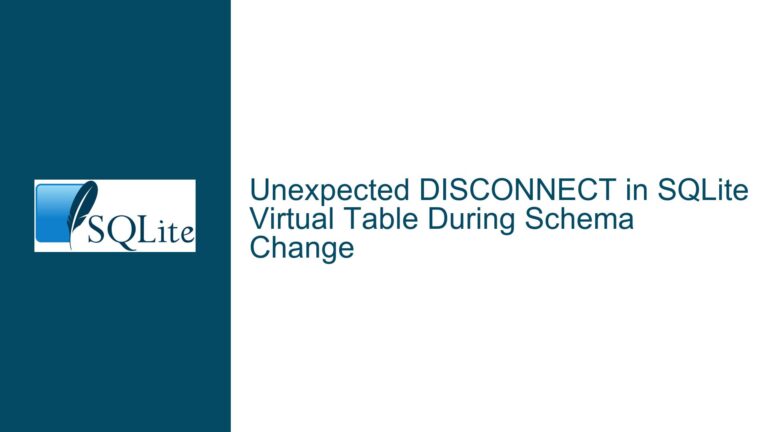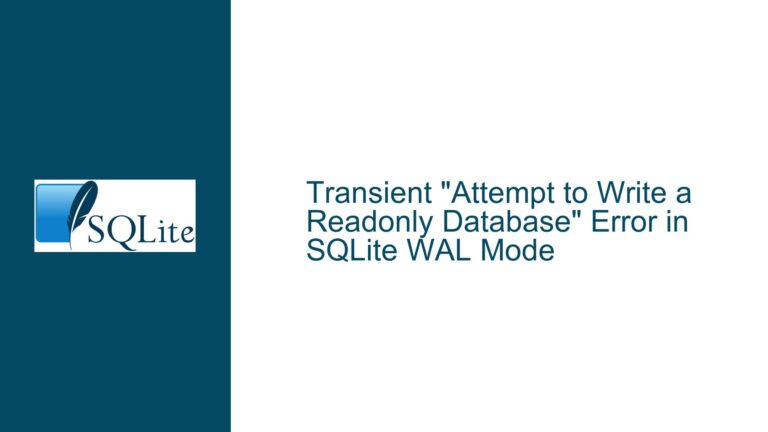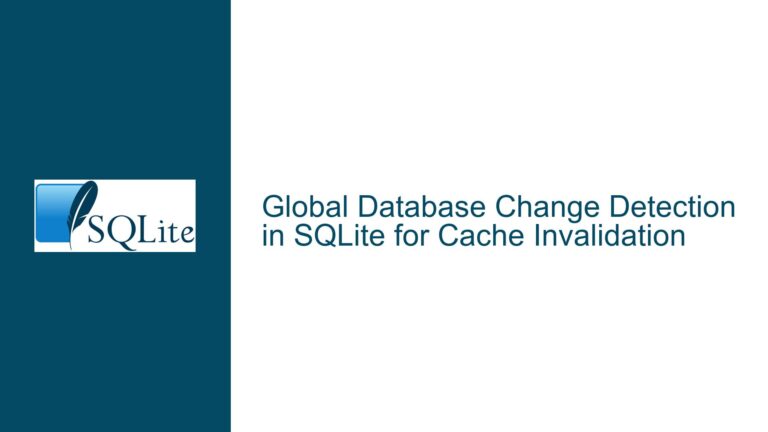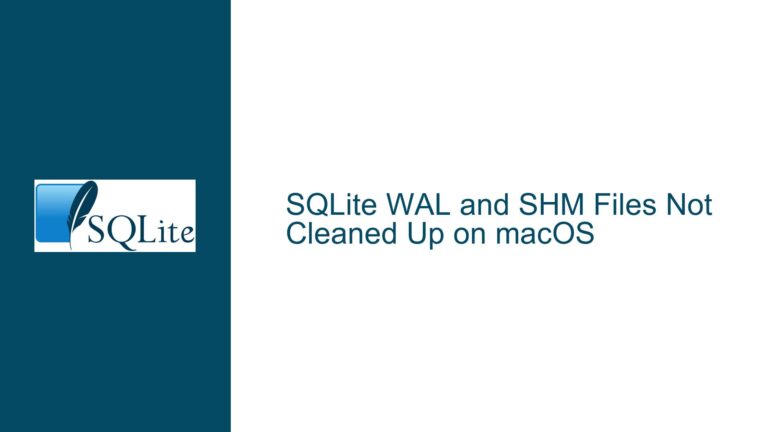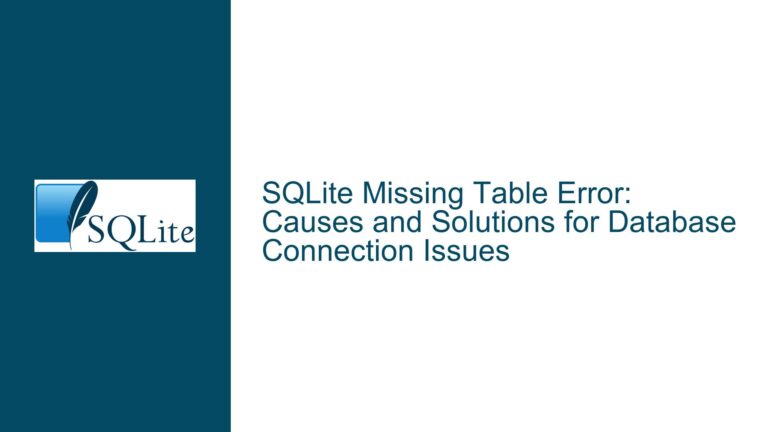Modifying C# Structs Passed as Pointers to SQLite Trace Callbacks: Safety and Validity Concerns
Issue Overview: Direct Modification of C# Structs via Pointers in SQLite Trace Callbacks
When interfacing with SQLite’s native C API from C#, developers often pass custom data structures (e.g., Ctx structs) as context pointers to callback functions registered via sqlite3_trace_v2. The core issue arises when attempting to modify these structures directly within the callback. Two critical concerns dominate:
- Memory Safety: Whether direct modifications to the struct’s fields (e.g.,
dbHandleordbName) will destabilize the application due to improper memory access. - Pointer Validity: Whether the pointer to the struct (
pCtx) remains valid throughout the callback’s execution or becomes invalidated by runtime behaviors like garbage collection (GC) or memory reallocation.
This problem is exacerbated by the interplay between C#’s managed memory environment and SQLite’s native API, which operates in unmanaged memory space. The Ctx struct in the example contains a mix of value types (int dbHandle) and reference types (string dbName), introducing complexity in how its memory is laid out and managed. When passing a pointer to such a struct to sqlite3_trace_v2, developers must ensure that the callback’s access to the struct adheres to the rules of both managed and unmanaged memory domains.
The user reports encountering errors when attempting to pass the struct by reference instead of a pointer. This suggests a mismatch between how the C# runtime marshals the struct and how SQLite’s native API expects to interact with it. Reference passing in C# (ref keyword) involves managed pointers, which are subject to GC relocation, whereas raw pointers (void* in C) require fixed memory addresses.
Possible Causes: Memory Management Conflicts and Type Marshaling Errors
Three primary factors contribute to instability when modifying Ctx structs via pointers in SQLite trace callbacks:
1. Garbage Collector Relocation of Managed Objects
C# structs are value types and are typically stored on the stack or inline within other objects. However, when a struct is passed to unmanaged code via a pointer, it must be pinned in memory to prevent the GC from relocating it during compaction. If the struct is not pinned, the pointer (pCtx) may reference an invalid memory location after a GC cycle, leading to undefined behavior, crashes, or data corruption.
The string dbName field poses additional risks. Strings in C# are reference types stored on the managed heap. When a struct containing a string is passed to unmanaged code, the runtime marshals the string as a pointer to a null-terminated UTF-8 or UTF-16 array. If the struct is not pinned, the GC may move the string’s memory, invalidating the pointer stored in dbName.
2. Non-Blittable Types and Incorrect Marshaling
A struct is blittable if its managed and unmanaged representations are identical, allowing direct copying without conversion. The Ctx struct is non-blittable due to the string field. When passed to unmanaged code, the runtime must marshal the string, which involves creating a temporary copy in unmanaged memory. Directly modifying the original dbName field in the callback will not affect this temporary copy, leading to inconsistencies.
If the callback attempts to modify the marshaled string, it may overwrite memory that the runtime does not expect to change, causing access violations. Similarly, the int dbHandle field is blittable, but concurrent modifications (e.g., from multiple threads) could result in race conditions if not properly synchronized.
3. Lifetime Management of the Context Pointer
The fourth argument to sqlite3_trace_v2 (pCtx) is a user-defined pointer that SQLite stores and passes to the callback on each invocation. If the Ctx struct is allocated on the managed heap (e.g., as part of a class instance), the pointer may become invalid if the object is garbage-collected before the callback is invoked. Even if the struct is allocated on the stack, it may go out of scope before the callback completes, leaving pCtx pointing to reclaimed memory.
Troubleshooting Steps, Solutions & Fixes: Ensuring Safe Struct Modification
To resolve these issues, developers must address memory pinning, type marshaling, and object lifetime management. Below are actionable steps to ensure safe modification of Ctx structs in SQLite trace callbacks.
Step 1: Pin the Struct in Managed Memory
To prevent GC relocation, use GCHandle.Alloc to allocate the struct in the pinned heap:
Ctx ctx = new Ctx { dbHandle = 123, dbName = "test.db" };
GCHandle handle = GCHandle.Alloc(ctx, GCHandleType.Pinned);
IntPtr pCtx = handle.AddrOfPinnedObject();
sqlite3_trace_v2(db, SQLITE_TRACE_STMT, traceCallback, pCtx);
Important:
- Keep the
GCHandlealive for as long as SQLite might invoke the callback. - Call
handle.Free()only after deregistering the trace callback or closing the database.
Step 2: Replace Non-Blittable Fields with Blittable Alternatives
Replace the string dbName field with a byte array or an IntPtr to a pinned UTF-8 string:
struct Ctx
{
public int dbHandle;
public IntPtr dbNamePtr; // Points to pinned UTF-8 string
}
// Allocate and pin the string separately:
byte[] dbNameBytes = Encoding.UTF8.GetBytes("test.db");
GCHandle nameHandle = GCHandle.Alloc(dbNameBytes, GCHandleType.Pinned);
ctx.dbNamePtr = nameHandle.AddrOfPinnedObject();
This ensures the entire Ctx struct is blittable and its memory layout matches SQLite’s expectations.
Step 3: Use Thread Synchronization for Concurrent Access
If the trace callback modifies Ctx fields while other threads access them, use locks or Interlocked operations:
object ctxLock = new object();
// In callback:
lock (ctxLock)
{
ctx.dbHandle = newValue;
}
Step 4: Validate Pointer Lifetime and Scope
Ensure the Ctx struct and any associated pinned memory (e.g., strings) outlive all potential callback invocations. For long-lived traces, consider storing the GCHandle in a static or long-lived object.
Step 5: Audit P/Invoke Declarations
Verify that the sqlite3_trace_v2 declaration correctly marshals the callback and context pointer:
[DllImport("sqlite3")]
static extern int sqlite3_trace_v2(
IntPtr db,
uint mask,
[MarshalAs(UnmanagedType.FunctionPtr)] SQLiteTraceCallback callback,
IntPtr pCtx
);
delegate void SQLiteTraceCallback(
uint traceMask,
IntPtr pCtx,
IntPtr pP,
IntPtr pX
);
Using IntPtr for pCtx ensures proper marshaling of the pointer.
Step 6: Test with Minimal Reproducible Examples
Create a minimal test case that isolates the struct modification:
// Allocate and pin
Ctx ctx = new Ctx { dbHandle = 0 };
GCHandle handle = GCHandle.Alloc(ctx, GCHandleType.Pinned);
// Register trace
sqlite3_trace_v2(db, SQLITE_TRACE_STMT, (mask, pCtx, p, x) => {
Ctx callbackCtx = (Ctx)Marshal.PtrToStructure(pCtx, typeof(Ctx));
callbackCtx.dbHandle++;
Marshal.StructureToPtr(callbackCtx, pCtx, false);
}, handle.AddrOfPinnedObject());
// Execute SQL and verify ctx.dbHandle increments
This verifies whether modifications are retained and pointers remain valid.
Final Solution: Safe Patterns for Callback Contexts
- Use Classes Instead of Structs: Classes are reference types and can be pinned more predictably.
- Centralize Context Management: Maintain a global dictionary of active contexts keyed by
IntPtr, allowing safe lookup in callbacks. - Leverage SQLite’s User Data APIs: Use
sqlite3_user_datafor per-connection context instead of raw pointers.
By adhering to these practices, developers can safely modify context data in SQLite trace callbacks without risking memory corruption or instability.

